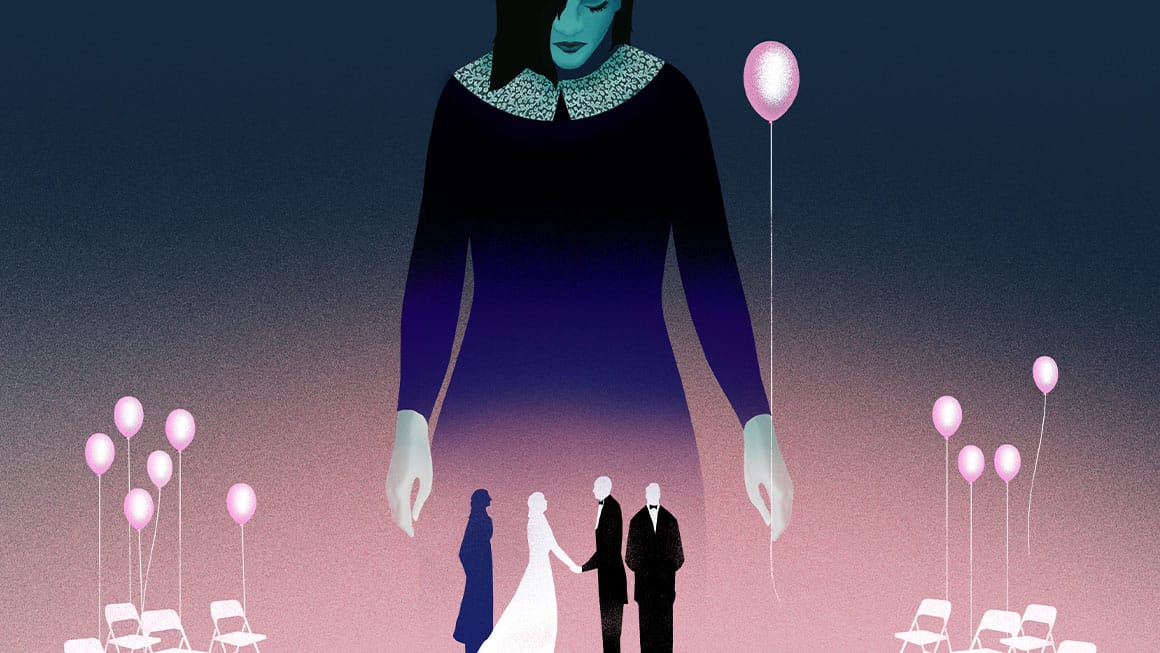June 1–21, 2024
In This Program
- About the Show
- Synopsis
- On the Other Side of Violence
- Decoding Innocence
- Holding Space, Taking Action: An Interview with Ryan Marchand
- Artists
- Donor Spotlight
- Print Edition
- Plan Your Visit
Innocence
Opera in five acts by Kaija Saariaho
Original Finnish Libretto by Sofi Oksanen
Multilingual Libretto and Dramaturgy by Aleksi Barrière
(Sung and spoken in English, Finnish, Czech, Romanian, French, Swedish, German, Spanish, and Greek with English and original language supertitles)
Cast
(in order of vocal appearance)
Student #4 (Anton)
Rowan Kievits *
Student #5 (Jerónimo)
Camilo Delgado Díaz *
Student #2 (Lilly)
Beate Mordal *
The Bride (Stela)
Lilian Farahani *
The Father-In-Law (Henrik)
Rod Gilfry
The Bridegroom (Tuomas)
Miles Mykkanen *
The Mother-In-Law (Patricia)
Claire de Sévigné *
The Teacher (Cecilia)
Lucy Shelton *
Student #6 (Alexia)
Marina Dumont *
The Waitress (Tereza)
Ruxandra Donose
Student # 1 (Markéta)
Vilma Jää *
Student #3 (Iris)
Julie Hega *
The Priest
Kristinn Sigmundsson
Actors:
Oksana Barrios *
Jordan Covington *
Victoria Fong *
Sam Hannum *
Jalen Justice *
Rachael Richman *
Brian Soutner *
Kevin Walton *
Chorus
* San Francisco Opera debut
Place and Time: Helsinki in the 2000s
ACT I
ACT II
ACT III
ACT IV
ACT V
Creative Team
Conductor
Clément Mao-Takacs *
Production
Simon Stone *
Revival Director
Louise Bakker *
Set Designer
Chloe Lamford *
Costume Designer
Mel Page *
Choreographer
Arco Renz *
Lighting Designer
James Farncombe *
Sound Designer & Mixing Engineer
Timo Kurkikangas *
Chorus Director
John Keene
Assistant Conductor
Edo Frenkel *
Prompter
Matthew Piatt
Musical Preparation
Kseniia Polstiankina Barrad
Noah Lindquist
John Churchwell
Fabrizio Corona
Diction
Olga Heikkilä
Patricia Kristof Moy
Simona Mihai
Radoslava Quinn
Assistant Director
Jose Maria Condemi
Stage Manager
Darin Burnett
Assistant Stage Managers
Megan Coutts
Jonathan S. Campbell
Anna Reetz
Dance Master
Colm Seery
Fight Director
Dave Maier
Technical Supervisors
Erik Walstad
Costume Supervisor
Galen Till
Hair and Makeup
Jeanna Parham
SATURDAY, JUNE 1, 2024 • 7:30 pm
FRIDAY, JUNE 7 • 7:30 pm
WEDNESDAY, JUNE 12 • 7:30 pm
SUNDAY, JUNE 16 • 2 pm
TUESDAY, JUNE 18 • 7:30 pm
FRIDAY, JUNE 21 • 7:30 pm
The performance will last approximately one hour and forty-five minutes with no intermission.
Latecomers may not be seated during the performance after the lights have dimmed.
To ensure the production is not disrupted, patrons who arrive late and those who leave their seats during the performance may be seated in available alternate locations and during appropriated breaks, at the discretion of San Francisco Opera Management.
The use of cameras, cell phones, and any kind of recording equipment is strictly forbidden.
Please turn off and refrain from using all electronic devices.
Synopsis
We are at a wedding reception in Helsinki, Finland. Stela met Tuomas while he was vacationing in Romania, and she’s fallen in love not only with him but also his country, the apparently peaceful Finland. Tuomas’ parents are relieved that he is moving forward with his life, but they cannot agree whether Stela should be told the truth about a horrific tragedy ten years prior. The tragedy starts emerging through the memories of six students and a teacher from an international high school.
One of the waitresses at the wedding reception has fallen ill, and a Czech waitress, Tereza, has been called in. She realizes with horror that she recognizes the family. The groom is the brother of a mass shooter at the international high school where Tereza’s daughter, Markéta, was brutally killed, ten years ago.
As the memories of the students bring us into the reality of the tragedy, Tereza must decide if she confronts the family, and the family must decide if they bring Stela into the truth. But the truth is not as straightforward as we might initially believe.
The story is intended to unfold in real time as we experience it as audience members. The full synopsis is also available, but please note that it does include plot spoilers.
First performance: Aix-en-Provence Festival, Grand Théâtre de Provence; July 3, 2021
First performance in the U.S.: San Francisco, California, War Memorial Opera House; June 1, 2024
Personnel: 21 principals, 40 choristers; 61 total
Orchestra: 3 flutes (first and second doubling piccolo, third doubling alto flute and piccolo), 3 oboes, 3 clarinets (third doubling bass clarinet),
3 bassoons (third doubling contrabassoon), 5 horns (4 + assistant),
2 trumpets, 3 trombones, tuba, timpani, 4 percussion, harp, piano, celesta,
34 strings; 65 total
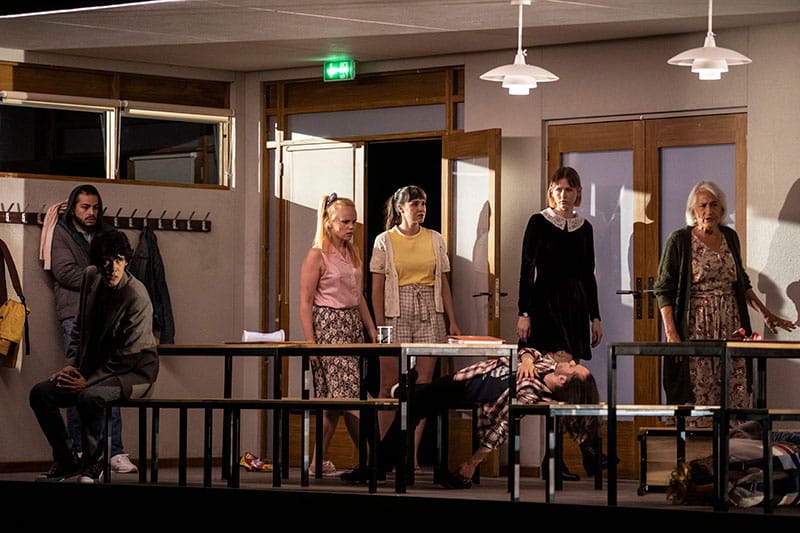
On the Other Side of Violence
By Aleksi Barrière
“There won’t be much talk of blood here. That you can find on TV, in movies, or in the newspaper.”
—Heinrich Böll, The Lost Honor of Katharina Blum, 1974
(Quoted in Aleksi Barrière’s music theater work Violences, 2019)
“Public narratives attach individual subjective meanings to larger cultural and institutional narratives. … The sociologist Margaret Somers calls the absence of these stories narrative silence. If an individual does not find a suitable public story for themselves, it is difficult for that individual to build their own subjectivity.”
—Sofi Oksanen, Too Short Skirt (Bonnier Books, 2011)
In the spring of 2013, Kaija Saariaho invited Sofi Oksanen and me to dinner. She had received a proposal from the Royal Opera House to write an opera inspired by the contemporary world and was excited to compose, for the first time, a work for the stage that she envisioned would contain numerous characters, languages, and perspectives on the same event. Kaija called the project Fresco. For this, she needed a virtuoso storyteller who could approach the complexity of our world through carefully crafted characters: Sofi. A dramaturg and translator familiar with opera was also needed because Sofi would be writing her first opera libretto, and she would do so in Finnish, whereas the final work would be multilingual. This was how I ended up at this first dinner, trying to answer Sofi’s first question: What subject has not yet been dealt with in an opera?
Of course, this question was about more than the allure of novelty. Operas have been written about the full range of human experience: love, jealousy, ambition, gods, tyrants, murderers, rapists, rebels, slavery. To what contemporary phenomenon could we apply the tools of opera to expand our understanding of the ways human beings cause and feel pain, and survive?
Three artists, three generations, three forms of expression. During our discussions, we saw the list of possible topics grow. Sofi had recently published her novel When the Doves Disappeared (2012), in which Estonian characters survive the Second World War and changes in government by fighting or adapting, lying to others and to themselves. Kaija was composing an opera based on a Noh play about a soldier whose traumatized ghost demands a ritual from the living to finally find peace (Only the Sound Remains, 2016). I had just directed a performance of the Kindertotenlieder, setting Mahler’s songs on the death of children in the aftermath of the Sandy Hook Elementary School shooting, and focused on the grieving of the parents (Tu ne dois pas garder la suite en toi, 2013). Fresco was something completely different from our other projects at the time, we thought. However, the questions troubling each of us were engaging in a secret conversation like the roots of trees underground. As our discussions progressed, Sofi worked on an original story about the revelation of a hidden crime from the past at a family party; she called it The Uninvited Guest.
Kaija had come up with a formal idea for a group fresco, in the style of Leonardo da Vinci’s Last Supper, and Sofi had drawn an association between that image and wedding photos, where solemn faces conceal hidden family dramas. The structure she built is similar to many of her novels: the interaction of two intertwining timelines, or narrative levels, sets off a series of revelations and gradually enriches our understanding of the characters. The implementation of this arc in this new work is, perhaps partly due to the density of the libretto form, one of Sofi’s most refined achievements as an author.
The characters grew as my translations were completed and started between the three of us via e-mail in the summer of 2016. Sofi polished the text and Kaija used recordings of the translations to develop a melodic and harmonic language for each character, from which the rest of the opera’s music grew. Our decision to give certain roles to actors instead of singers enabled both a larger use of text and new ways for Kaija to weave it into the music.
The work was no longer just Fresco, an abstract polyphonic form, and not simply The Uninvited Guest, the dilemma of an individual in relation to a group. We were giving birth to Innocence, a drama of thirteen people’s guile and self-recrimination; each the isolated prisoner of their own trauma yet simultaneously bound through shared trauma.
In the same way, languages isolate people as much as they bring them together. In Innocence, the multiple languages coil the text and music together into an exploration of the layered desolation of our world.
When the work was rehearsed for the first time in the summer of 2020, amid pandemic restrictions, it proved to be as important as it was challenging to build an opera that, by its very nature, required artists of different languages and disciplines to come together and create something in common. Beyond the message, the medium is a method.
So how did this answer Sofi’s original question of addressing a new topic with the tools of opera and language? Sofi developed a wonderful answer with her libretto. She used the example of a school shooting and an abundance of roles to show how multifaceted and utterly structural the creation of violence is. A bloody act committed by a young person is always considered, as the libretto recalls, an “inexplicable” tragedy. Sofi’s text evokes the superficial public debate chat occurred following the Columbine, Dunblane, or Kauhajoki shootings: plenty of talk about youth violence, about the graphic nature of film and video games, and sometimes about the availability of guns. These are factors we could and should address better as a society.
However, broader questions remain taboos. These taboos arise from our rigid understanding of what falls under individual responsibility, from problems we fail to see as societal—such as mental health—and from the silent violence produced by workplaces, families, and communities. Innocence considers how problematic our choices can be if we do not examine our own values and motives, and if we cling vehemently to convenient roles and narratives. Through its thirteen character arcs on loneliness and connection, the opera reminds us of the importance of bringing hidden stories to light, into public discourse: giving visibility to all narratives and to their interplay.
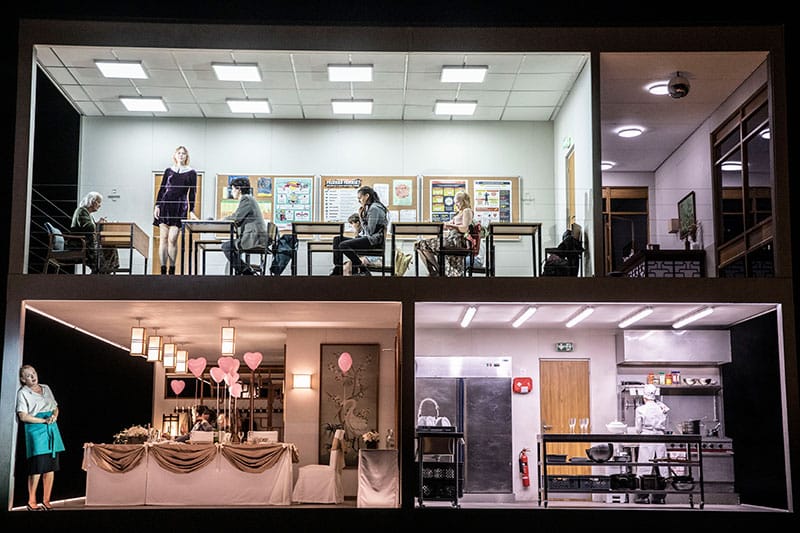
Only in a multilingual musical work for the stage is it possible to polyphonically weave together so many stories and interactions. However, artistic expression not only has a responsibility to present public narratives and our struggles with them; it must reflect on how they should be presented. As studies have shown, school shooters often revel in images created by the film industry on the topic, just as members of the military enjoy watching and quoting scenes from war films, even those that take a pacifist stance. How, then, can art avoid tolerating, normalizing, or even encouraging violence while simultaneously depicting it? In the development phase of Innocence, the earliest and perhaps most radical decision we made was to exclude all physical violence—the shooting, and even the shooter himself—from the text and music, spotlighting, instead, the stories and voices that receive less visibility in a society enamored with spectacle. In focusing on slower timelines of grieving and healing, Kaija’s music embraces the psychological reality of memory, trauma, repression, and acceptance. Associative dream-state logic becomes more truthful and also more engaging than the thrill of pseudo-realistic spectacle.
Alongside choreographer Arco Renz, director Simon Stone has developed a beautiful way of centralizing trauma and giving it physical reality. As a skilled creator of images, Simon has also tried to tease the viewer’s expectations of visible violence, and part of his process has been to carefully dose the physical violence and appearance of the shooter. It would be interesting to see a production in the future that fully adopts the distinguishing principle of the text and music, and completely rejects the macabre fascination with violence that the mass media has cultivated in us.
As an art form, theater has an obligation not only to critique mainstream images but also to develop new images that are lacking in the homogenized public space. This opera is an invitation and a tool in that direction.
For its creators, it has been a continuation of our previous work and its climax. Above all, we hope it will inspire others to give visibility to the missing narratives we need and encourage many difficult and necessary conversations.
Aleksi Barrière is the dramaturge-translator of Innocence, responsible for the composed multilingual version of the libretto. He is also the stage director and co-artistic director of the music theatre collective La Chambre aux échos and a specialist on innovative forms of interdisciplinary and intercultural creation.
Photos: Jean-Louis Fernandez/Festival d’Aix-en-Provence
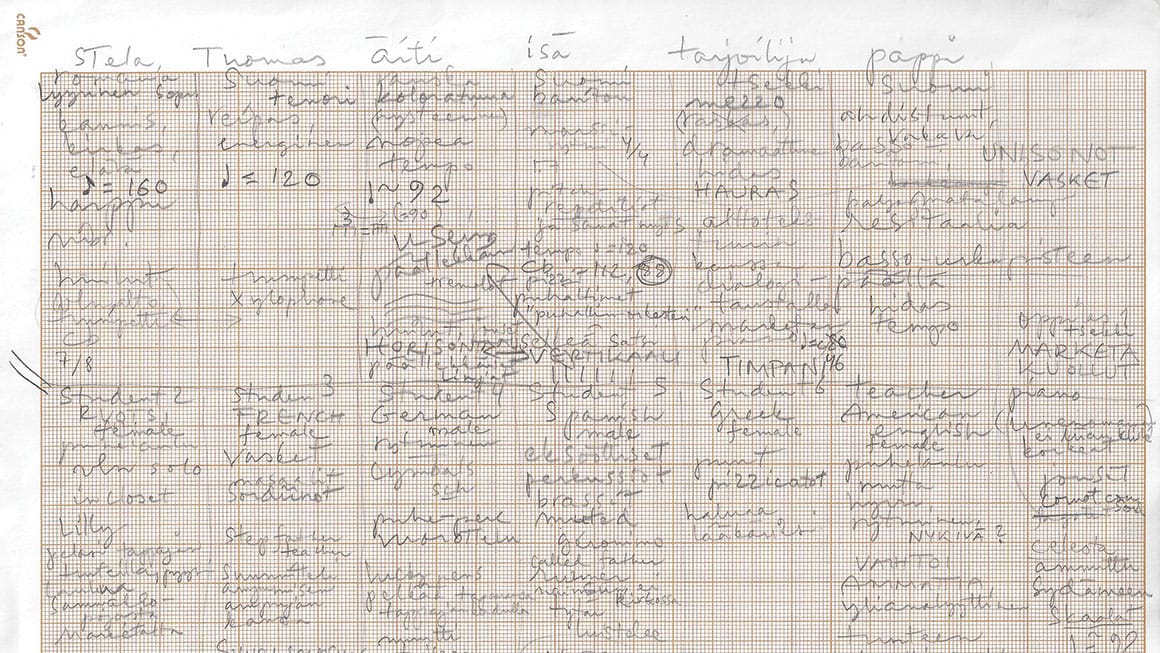
Decoding Innocence
Conductor Clément Mao-Takacs and General Director Matthew Shilvock explore Saariaho’s sketches for the opera
Matthew Shilvock: Clément, thank you for helping us demystify these incredible documents that we have from Kaija Saariaho. These are documents that I got to glimpse when I visited her in Paris back in 2019. They stuck with me as an incredible insight into the compositional process of one of the great composers of our time. After she sadly passed, I asked [her son] Aleksi if he could find these, and he was able to and shared them. For me, they were a moment-in-time glimpse into her compositional process. But you were someone who was right there with her through that journey. I wonder if you could help set those documents in the context of how she approached the composition of Innocence?
Clément Mao-Takacs: Yes! First of all, these sketches are incredibly moving because it’s like entering the laboratory and being in the kitchen of the composer herself. It’s very intimate. And I must confess that when you asked me [to talk about the sketches], I was divided in two. One part of me was really excited to look at them because a lot of these sketches I never saw before; Kaija kept them very private. At the same time I was really moved by this entrance into this intimacy because, yes, it’s really something very moving—especially because she was always using this graph paper, which is typical of Kaija’s sketches. You see her handwriting, and you probably notice she was left handed. The way she writes some words, some numbers, some ideas is very emotional. It’s very touching because in looking at these sketches I feel like she’s still here.
We see some cues, some elements and can recognize some words or ideas that Kaija shared during the composing process. But some ideas, some words, some things will remain always mysterious. And I think there is something really beautiful in how art keeps this kind of mystery still.
MS: They’re keys into the work but only in a certain way.
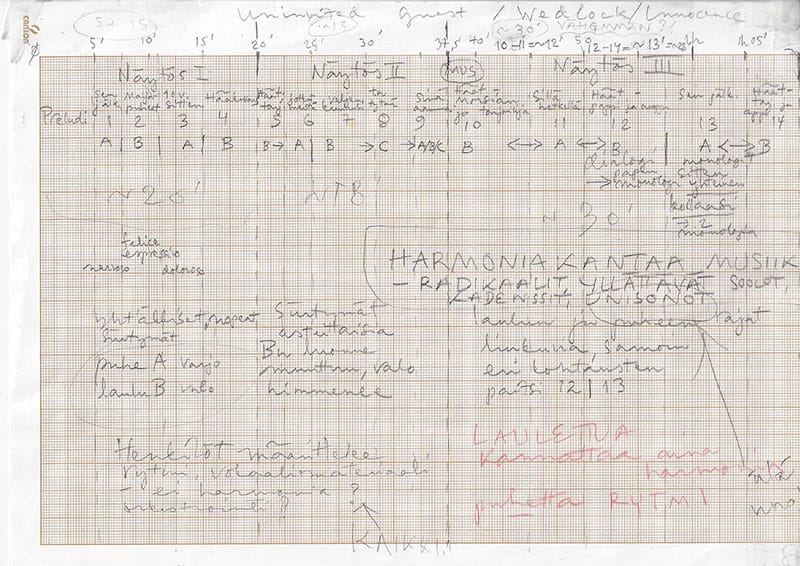
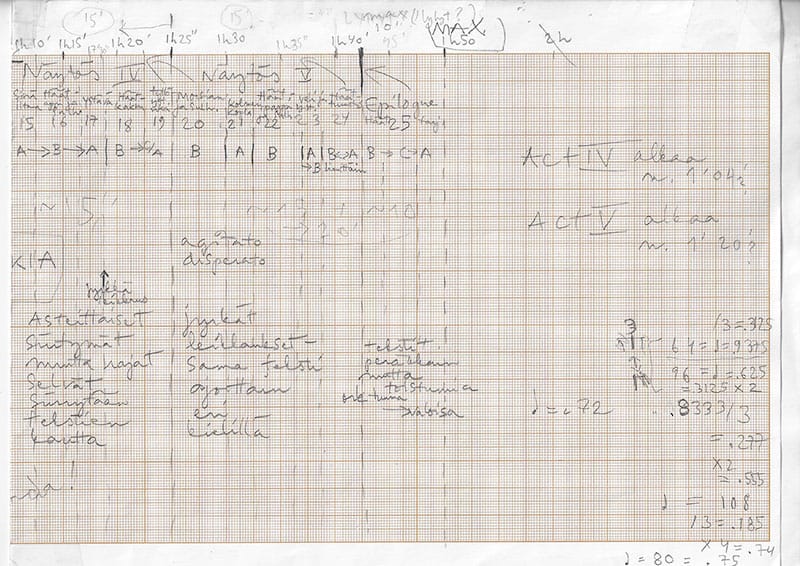
Kaija Saariaho’s sketches for the overall structure of Innocence, showing each of the five acts broken out by scenes and minutes with structural elements and characterizations. Also seen are various versions of the title and mathematical workings out of tempo relationships. / KAIJA SAARIAHO, PAUL SACHER FOUNDATION, BASEL
CMT: Yes, it’s a kind of archeological study that we are trained to do. So we have some stones, we have some columns, we have a clear idea of what the temple looks like, but in these sketches we have only the very first ideas of this Greek or pharaonic architecture.
MS: Do you have a sense of how these sketches worked in her compositional timeline? Do you feel that all of these sketches were done before she started composing a note of music, or were they things that she worked on simultaneously with the compositional process?
CMT: I think she was doing both: thinking and having already some music in her.
It’s of importance that it’s written on graph paper, because it’s a mathematical thing. And it’s also about drawing. At the beginning of her career, Kaija was very attracted by the fine arts, by drawings … she painted. So for her to draw a line in the architecture was also important. And very often a color or a line could be the beginning of the construction.
We can see this on the page where she wrote different characters. It’s very interesting because each character has its own definition, its own tempo, its own expression, its own orchestration, its own dynamics, rhythm, style of singing, style of speaking, even sometimes style of Sprechgesang (“talk-singing”).
We had a conversation about the metronome marks. For her, the tempo of each character was related to the psychological side, and the tempo is the blood flowing inside the body of all these characters. So sometimes it’s going really fast and sometimes it’s slower. Sometimes the atmosphere is very rhythmical, and sometimes it’s just like what she called a soup, an atmosphere.
She used this musical material very precisely for each character, and it really helps the listener and also the conductor because it creates a very strong structure, and you can recognize immediately which character is speaking, which scene is acting, and also if you are in the past or in the future or in the present.
There is a kind of magic in the composing process, especially for composers like Kaija who are so involved. I think it’s something we can see in these sketches: How deeply she [felt when] composing.
MS: How you’ve expressed that makes me think of the spectralist duality: something very mathematical but also very organic. The idea that the music is almost born out of itself and of its mathematical structure. We hear that orally. We also see it in a way linearly here on the page. This is a piece that is crafted very deliberately to allow it to be organic, to allow the listener to feel it in the way that Kaija wishes us to experience it. It’s a really beautiful duality, as you say. This is such a unique musical experience for people. It takes the audience into a completely transcendent place.
We could take Innocence to be about individual lives, dreams, problems, shames, joys or desires, people trying to find solutions that are not always good but that are human solutions from our failures and excesses. But at the same time, Innocence is about the fact we are not alone, even when we think we are alone in our room or in our brain. We’re part of a community. It’s something that I see in Kaija’s sketches.
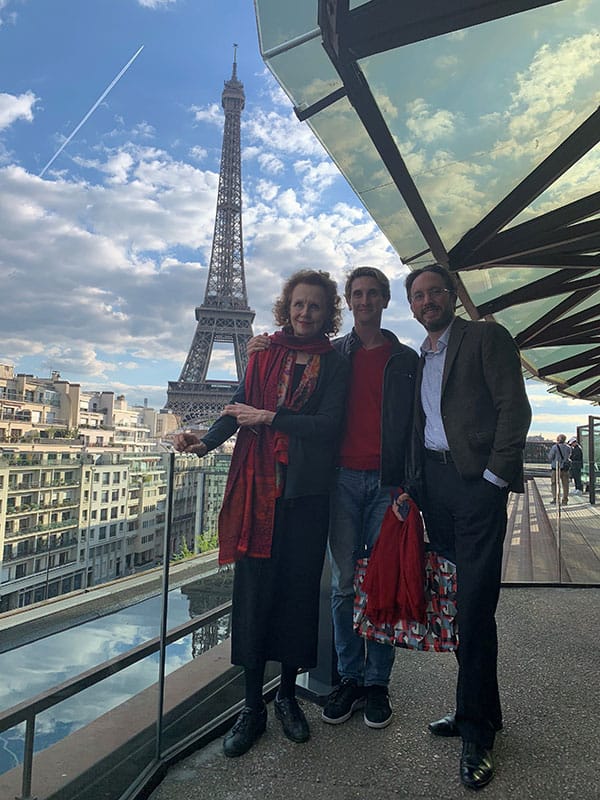
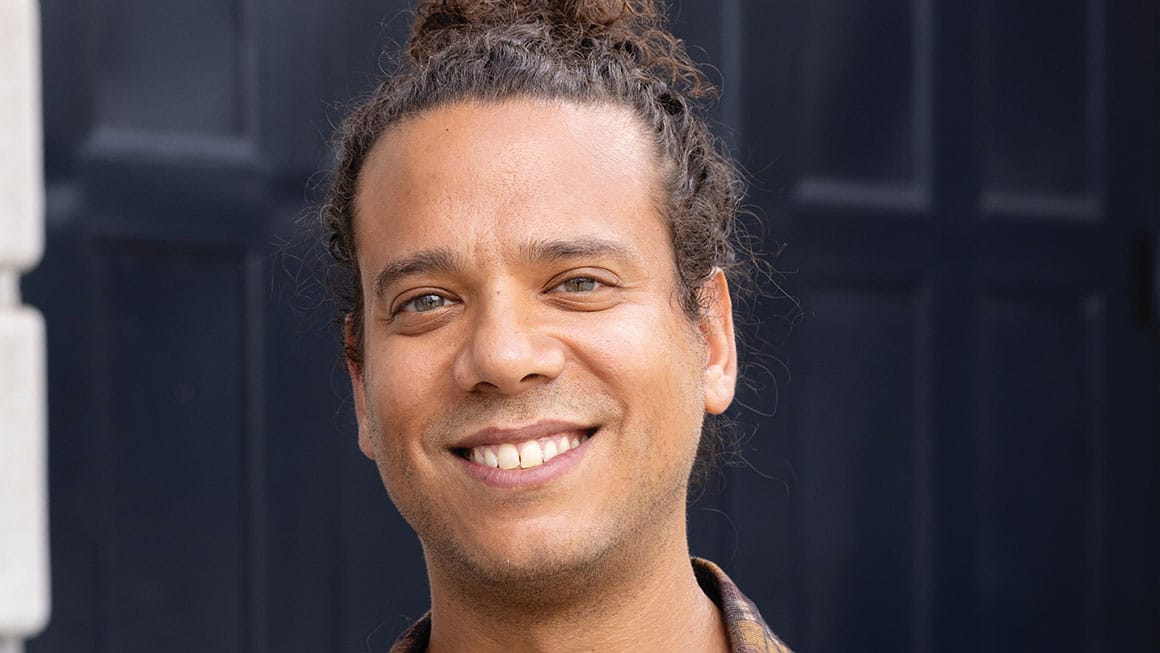
Holding Space, Taking Action: An Interview with Ryan Marchand
By Elena Park
As he prepared for community-wide events around the U.S. premiere of Kaija Saariaho’s Innocence, Ryan Marchand was struck by wisdom contained in the book After the Bloodbath: Is Healing Possible in the Wake of Rampage Shootings? by James D. Diamond. “It was a foundational resource for us,” recalls Marchand, who leads San Francisco Opera’s Department of Diversity, Equity, and Community (DEC). “It compared the retributive American justice system to different indigenous American justice systems. Indigenous societies tend not to ostracize the family of a shooter; they’ll still allow that person a funeral, and the town will attend, and together they embrace the fear. That brought forth the themes of connection and restorative justice, and the recognition that we’re all people capable of committing harm.”
That empathetic approach–for a community to come together rather than be torn apart in the aftermath of violence–informed the expansive series of public programs that San Francisco Opera will be presenting in conjunction with the work’s run at the War Memorial Opera House. A free, daylong symposium on May 31 will feature leaders such as Pastor Mike McBride, Human Rights Commissioner Sheryl Davis, UCSF trauma surgeon Rochelle A. Dicker, GIFFORDS’ Mike McLively, as well as moderators W. Kamau Bell and KQED’s Mina Kim; they will join other civic leaders, artists, and activists in addressing topics such as full circle advocacy, depicting trauma in the arts, and the power of community.
After each performance of Innocence, San Francisco Opera and its partners will offer audiences space for dialogue (which may range from storytelling to advocacy), reflection, and healing. Taken together, the BEYOND INNOCENCEevents will explore resilience and healing; innocence, guilt, and forgiveness; the prevention of gun violence; and communal action.
Live Free USA and Lumahai Productions will co-present the BEYOND INNOCENCE symposium with San Francisco Opera, joining partners including Collective Impact, Community Arts Stabilization Trust (CAST), GIFFORDS Law Center to Prevent Gun Violence, and the UCSF San Francisco Wraparound Project—all partners in the collective efforts to use the opera as a springboard. Working together, they will share resources and disparate perspectives, with the goal of creating connectivity across sectors to achieve focused outcomes.
As the DEC team organized training sessions for staff and artists in advance of the run, and considered what the Company could offer audiences following performances of Innocence, one touchpoint was the work of artist and scholar Byron Au Yong, including their devised theatrical work with survivors of mass shootings. “He talked about our understanding of trauma, and that you’ll never be able to predict what people are going to need,” explains Marchand. “Normally, people would leave the theater and then maybe talk about it at dinner, but what would happen if you’d created intentional spaces for that kind of processing to happen?
“Early on, GIFFORDS told me that one of the toughest challenges to address is hopelessness,” he continued. “By coming together, we can demonstrate that there are actual paths to interrupting violence. I hope people walk away understanding that there are actionable things that we can do today and that the arts have a role to play in all of that.”
Elena Park is a co-curator, with Pastor Mike McBride and Ryan Marchand, of the BEYOND INNOCENCE symposium on May 31. For more information on the full slate of events, including post-show activations, visit sfopera.com/beyond-innocence.
Artists

Donor Spotlight
John A. & Cynthia Fry Gunn
Once again, the unprecedented generosity of Cynthia and John Gunn has set the stage for a dazzling season at San Francisco Opera. Since 2002, when John joined the Opera Board, the couple has underwritten numerous productions and provided exceptional support for many of the Company’s innovative endeavors. In September 2008, the Gunns made a historic commitment—believed to be the largest gift ever made by individuals to an American opera company—to help fund the signature projects of then General Director David Gockley, including new operas and productions, multimedia projects, and outreach programs, and they have proudly continued that support for General Director Matthew Shilvock. This season, the Gunns’ inspired generosity is helping make possible four productions— Il Trovatore, The (R)evolution of Steve Jobs, Lohengrin, and The Magic Flute. The Gunns invite everyone to give and join them as a member of San Francisco Opera’s donor community. John comments, “Opera is a dynamic art form, and all of us play a role in keeping it a meaningful part of our social fabric. With you we can propel San Francisco Opera into its next 100 years of artistic history.” John is the former chairman and CEO of Dodge & Cox Investment Managers. He joined the firm in 1972, the year he received his MBA from Stanford Business School and married Cynthia, who graduated from Stanford with an A.B. in political science in 1970. Early in her career, Cynthia was the editor and director of The Portable Stanford book series for 10 years. She edited 28 books by Stanford professors on a vast array of topics, including Economic Policy Beyond the Headlines by George Shultz and Ken Dam. In addition to their support of San Francisco Opera, the Gunns are active members of the community. John is a former trustee of Stanford University and is Chairman Emeritus of the Advisory Board for the Stanford Institute for Economic Policy Research. Cynthia currently serves as a trustee of the Fine Arts Museums of San Francisco, is a former overseer of Stanford’s Hoover Institution, and has been a member of the advisory board of Family and Children Services and the board of the Lucile Packard Foundation for Children’s Health. Opera lovers are grateful to Cynthia and John and applaud their commitment to keeping San Francisco Opera a leading-edge company.
Phyllis C. Wattis Fund for New Productions (Production Sponsor, Innocence)
San Francisco Opera will always owe a debt of gratitude to Phyllis C. Wattis for her many generous and visionary gifts to San Francisco Opera that include an endowment that established the Phyllis C. Wattis Fund for New Productions. Mrs. Wattis passed away in June 2002 at the age of 97. During her life she generously supported many Bay Area nonprofit organizations, and was especially interested in the arts, contributing also her time, wisdom, and leadership to the fine arts and the performing arts. She served prominently on the boards of San Francisco Museum of Modern Art, Fine Arts Museums of San Francisco, San Francisco Opera, and San Francisco Symphony, and was a committed financial and ideological supporter of each of these organizations as well. Mrs. Wattis helped underwrite San Francisco Opera’s world premiere productions including Dangerous Liaisons (1994), A Streetcar Named Desire (1998), and the critically acclaimed Dead Man Walking (2000). San Francisco Opera deeply appreciates the many generous gifts from Mrs. Wattis and takes this opportunity to recognize the Phyllis C. Wattis Fund for New Productions for its sponsorship support of The Makropufos Case (2010), The Flying Dutchman (2013), Two Women (2015), Così fan tutte (2021), Fidelio (2021), Don Giovanni (2022), and Antony and Cleopatra (2022).
Louise Gund (Production Sponsor, Innocence)
Louise Gund has a lifelong passion for the arts and is both a photographer and a theatrical producer. She has produced twelve Broadway plays and musicals, winning a Tony Award and Drama Desk Award for All the Way, and receiving three additional Tony Award nominations. A subscriber to San Francisco Opera since 2010, Louise has served on the Opera’s board of directors since 2013. She has also served on the boards of the Oregon Shakespeare Festival, Cal Performances, Earthjustice, and the Berkeley Community Chorus and Orchestra. In addition to her major support of these organizations, she is an environmental activist and a staunch advocate on behalf of women’s and children’s issues. She was awarded the San Francisco Opera Spirit of the Opera Award in 2019 for devoted service to the Company, and was the inspiration behind the Opera’s Producers Circle. Louise is passionate about enabling creativity to flourish, telling stories of meaning, and ensuring a vibrant future for the arts.

Print Edition
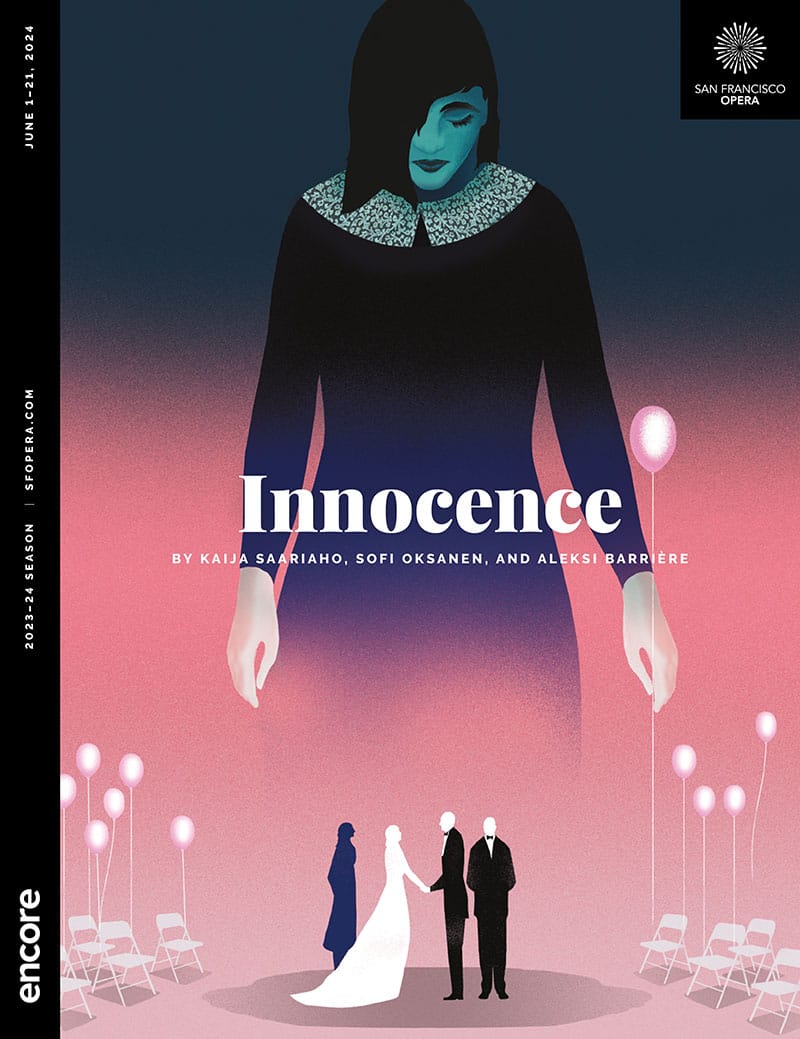

Plan Your Visit
Visit SFOpera.com for more information on the following topics
New to opera? First things first, welcome! Second, feel free to skim our short list of good-to-knows before joining us.

